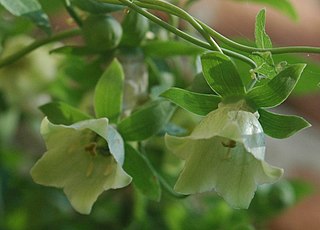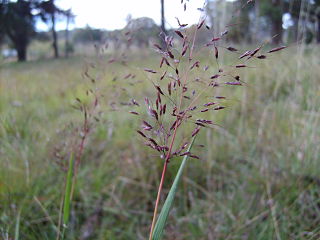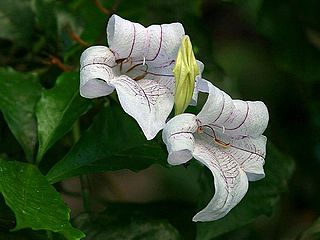
Acanthaceae is a family of dicotyledonous flowering plants containing almost 250 genera and about 2500 species. Most are tropical herbs, shrubs, or twining vines; some are epiphytes. Only a few species are distributed in temperate regions. The four main centres of distribution are Indonesia and Malaysia, Africa, Brazil, and Central America. Representatives of the family can be found in nearly every habitat, including dense or open forests, scrublands, wet fields and valleys, sea coast and marine areas, swamps, and mangrove forests.

Cymbopogon, also known as lemongrass, barbed wire grass, silky heads, oily heads, Cochin grass, Malabar grass, citronella grass or fever grass, is a genus of Asian, African, Australian, and tropical island plants in the grass family. Some species are commonly cultivated as culinary and medicinal herbs because of their scent, resembling that of lemons . The name cymbopogon derives from the Greek words kymbe and pogon "which mean [that] in most species, the hairy spikelets project from boat-shaped spathes." Lemongrass and its oil are believed to possess therapeutic properties.

Northeast India, officially known as the North Eastern Region (NER), is the easternmost region of India representing both a geographic and political administrative division of the country. It comprises eight states—Arunachal Pradesh, Assam, Manipur, Meghalaya, Mizoram, Nagaland and Tripura, and the "brother" state of Sikkim.

Epiprinus is a genus of plant of the family Euphorbiaceae first described as a genus in 1854. It is native to Indochina, Sumatra, southern China, and the Indian Subcontinent.
- Epiprinus balansae(Pax & K.Hoffm.) Gagnep. - Vietnam
- Epiprinus lanceifoliusCroizat - Vietnam
- Epiprinus malayanusGriff. - Myanmar, Thailand, Peninsular Malaysia, Sumatra
- Epiprinus mallotiformis(Müll.Arg.) Croizat - southern India
- Epiprinus poilaneiGagnep. - Vietnam
- Epiprinus siletianus(Baill.) Croizat - Hainan, Yunnan, Assam, Laos, Myanmar, Thailand, Vietnam
Athroisma is a genus of plants in the family Asteraceae first described as a genus in 1833. It is native to East Africa and Madagascar.
Francis Kingdon-Ward, born Francis Kingdon Ward OBE, was an English botanist, explorer, plant collector and author. He published most of his books as Frank Kingdon-Ward and this hyphenated form of his name stuck, becoming the surname of his wives and two daughters. It also became a pen name for his sister Winifred Mary Ward by default.

Ruellia is a genus of flowering plants commonly known as ruellias or wild petunias. They are not closely related to petunias (Petunia) although both genera belong to the same euasterid clade. The genus was named in honor of Jean Ruelle (1474–1537), herbalist and physician to Francis I of France and translator of several works of Dioscorides.

Codonopsis is a genus of flowering plant in the family Campanulaceae. As currently recognized, Codonopsis includes two other groups sometimes separated as distinct genera, i.e. Campanumoea and Leptocodon. The enlarged genus Codonopsis is widespread across eastern, southern, central, and southeastern Asia, including China, Japan, the Russian Far East, Kazakhstan, the Indian Subcontinent, Iran, Indochina, Indonesia, etc.

Ruellia simplex, the Mexican petunia, Mexican bluebell or Britton's wild petunia, is a species of flowering plant in the family Acanthaceae. It is a native of Mexico, the Caribbean, and South America. It has become a widespread invasive plant in Florida, where it was likely introduced as an ornamental before 1933, as well as in the eastern Mediterranean, South Asia and other parts of the eastern hemisphere.
Ruellia multifolia is a species of flowering plant in the family Acanthaceae. It is a perennial or subshrub native to west-central, southern, and southeastern Brazil, northeastern Argentina, and Paraguay.

William Griffith was a British doctor, naturalist, and botanist. Griffith's botanical publications are from India and Burma. After a brief stay in Madras, he was assigned as a Civil Surgeon to Tenasserim, Burma, where he studied local plants and made collecting trips to the Barak River valley in Assam. He explored various parts of Burma, traveling the rivers, including the Irrawadi as far as Rangoon. He visited the highlands of Sikkim, and the region of the Himalayas around Shimla. Subsequently, Griffith was appointed as Civil Surgeon in Malacca, where he died of a parasitic liver disease.

Sapria himalayana, commonly known as the hermit's spittoon, is a rare holoparasitic flowering plant related to Rafflesia found in the Eastern Himalayas. Sapria himalayana represents the extreme manifestation of the parasitic mode, being completely dependent on its host plant for water, nutrients and products of photosynthesis which it sucks through a specialised root system called haustoria. These haustoria are attached to both the xylem and the phloem of the host plant.

Dendrobium moschatum, the musky-smelling dendrobium, is a species of orchid. It is native to the Himalayas, and Indochina.

Pseudoraphis is a genus of Asian and Australian plants in the grass family, commonly known as mudgrasses.

Capillipedium is a genus of plants in the grass family. They are native to Africa, Asia, Australia, and certain islands in the Western Pacific.

Paphiopedilum insigne is an Asian species of slipper orchid and the type species of the genus Paphiopedilum. Its name is derived from the Latin insigne, meaning 'badge of honor' due to the magnificent flower. In the 19th century it was very popular among European and American orchid growers, causing it to become very rare in the wild due to over collecting. There are many varieties of it and hybrids with it.

Tripidium bengalense, synonym Saccharum bengalense, with the common names munj sweetcane, baruwa sugarcane or baruwa grass, is a plant of the genus Tripidium native to Iran, Afghanistan, Pakistan, Northern India, Nepal, Bangladesh and Myanmar.
Iris griffithii is a plant species in the genus Iris, it is also in the subgenus Iris. It is a rhizomatous perennial, from Afghanistan. It has short, sickle-shaped leaves, short green stem and purple flowers with white beards. Several specimens exist within herbaria around Europe, but it is rarely cultivated.

Mackaya is a genus of flowering plants in the family Acanthaceae, disjunctly distributed in South Africa and the eastern Himalayas, Southeast Asia, and China. It is sister to Asystasia.
Calamus jenkinsianus is an Asian species of rattan in the family Arecaceae and the tribe Calameae; it is widely known under its synonym Daemonorops jenkinsiana. It has been recorded from: Assam, Bangladesh, Cambodia, China Southeast, East Himalaya, Hainan, Laos, Myanmar, Taiwan, Thailand and Vietnam,.















